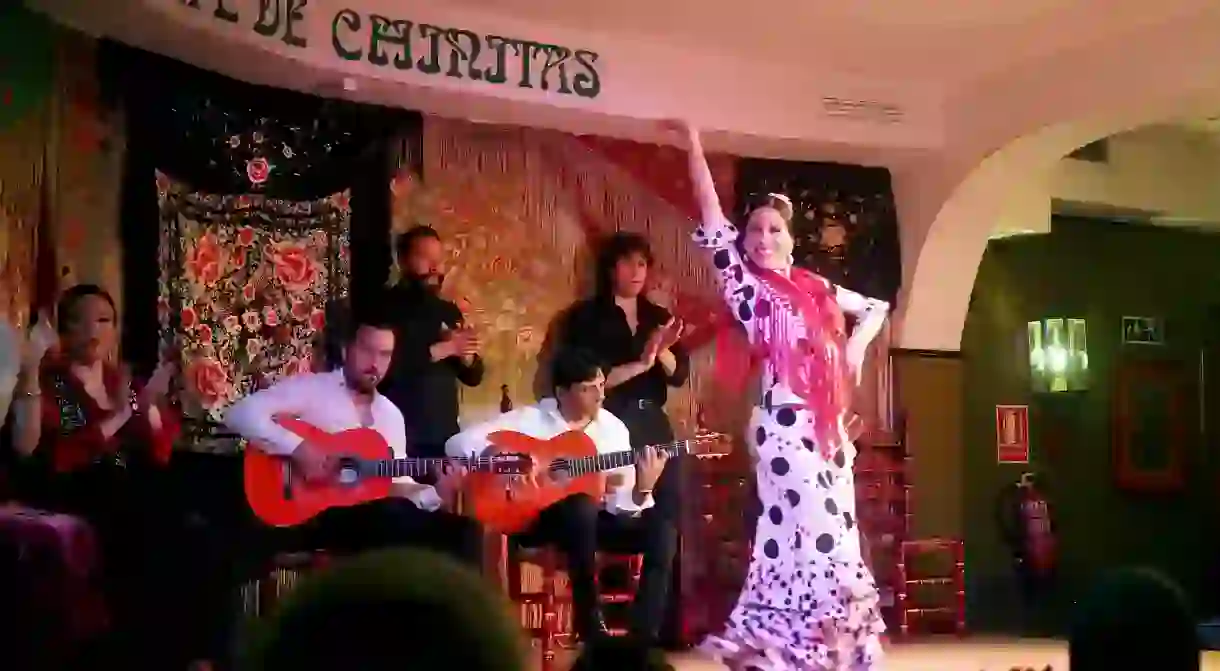How Madrid’s Tablaos Redefined Flamenco

While flamenco has its origins in southern Spain, Madrid’s tablaos have borne witness to pivotal moments in flamenco’s history. Here, two of the city’s tablaos – the world’s oldest and the newest to arrive on the scene – share their stories.
In 1973, when the late guitarist Paco de Lucía first performed his work ‘Entre dos Aguas’, he changed the landscape of flamenco music forever. While a flamenco performance traditionally consists of a somewhat improvised back and forth between dancer, guitarist and singer, ‘Entre dos Aguas’ was one of the first examples in flamenco of a whole, autonomous musical composition, with a beginning and an end – and it sent ripples across the world of flamenco music and dance.
The premiere of this famous work took place at Corral de la Morería, the oldest flamenco tablao still running in Spain. Madrid’s numerous tablaos are places to eat and drink while watching a flamenco show, combining the theatrical possibilities of stage performance with the closeness and intimacy of flamenco in its most authentic form. Corral de la Morería has long been a firm favourite not only among flamenco fans but in foodie circles, too. With Basque chef David García at the helm in the kitchen, it solidified its reputation as an haute-cuisine establishment in 2019 when it was awarded a Michelin star.
It’s an illustrious brand, yet very much a family business. The owner, Juan Manuel del Rey, took over from his father who founded the establishment in 1956, and his mother, the dancer Blanca del Rey, continues as artistic director to this day.

“My father wanted to invent something that didn’t exist,” Juan Manuel tells Culture Trip. “A place that brought together high gastronomy and the best flamenco programming. It was difficult to take off in the first few months – this was a new concept, so it took time for people to understand it.”
Back in the ’50s, flamenco artists were highly undervalued; they occupied an underground space, living from one odd job to another, lacking any real stability and support. Corral de la Morería represented a shift in the status of such artists, not least by attracting the interest (and deep pockets) of Madrid’s wealthy elite and the Hollywood glitterati that famously frequented the Spanish capital at the time.
Juan Manuel speaks to Culture Trip soon after the close of Zincalí, a new show choreographed by Antonio Najarro (former director of the Ballet Nacional de España), with outfits designed by Spanish couturier Oteyza. Zincalí is one of the productions that Corral de la Morería itself now commissions and produces every year. This is more than just a stage for performers; even since its early days, Corral de la Morería’s residency-style approach allowed artists the space to create and develop work.

Dancer Mónika Rojas is well versed in the flamenco stages of Madrid. She has performed at nearly all of the city’s emblematic tablaos over her 20-year career. In December, she opened a tablao of her own, La Fragua, in the heart of the city centre.
“It’s every artist’s dream to have their own tablao,” says Mónika. Her new artist-led establishment is a departure from the typical tablao, traditionally run by hospitality professionals. “We wanted to get away from stereotypes,” she explains. “No polka dots, shawls and flowers. We didn’t want to be put in the same box as everything else out there.”
Rojas’s venue is a homage to the ancient foundries of Andalusia, where the oldest forms of flamenco songs are said to originate, with Gypsy blacksmiths singing words of sorrow and hardship to each other while working. The design of the space has an industrial feeling, featuring exposed-brick walls and cement floors, decorated with metal tools. It’s a fitting addition to the trendy restaurant and bar scene in Malasaña, a Madrid neighbourhood where many of the nearby venues might opt for a similar industrial aesthetic. In the case of La Fragua, however, this contemporary design actually takes us back to a deep, primitive part of Spanish culture and identity.
Although southern Spain is the birthplace of flamenco, Madrid has always offered artists a platform like no other. Even for the best artists from Andalusia, Madrid was the place to make it; over the years, major defining moments for flamenco have taken place in the city’s tablaos, reshaping the tradition into its contemporary form. “It’s true that flamenco was born in Andalusia,” explains Juan Manuel del Rey. “But many flamenco artists are also from Madrid, Barcelona, Extremadura, Murcia – or even Japan, France and the USA. Just like jazz, flamenco is an international art.”
Dancer Magdalena Mannion is inclined to agree. Originally from London, she has been living in Madrid for 10 years now and performs at many of the city’s renowned tablaos, including Casa Patas, Café de Chinitas and Corral de la Morería.
“Tablaos are held in very high regard,” she explains. “It seems like an informal setting, but that doesn’t mean that the technical expectations are any less. An artist might headline a big festival, but then you’re lucky enough to catch them really close up in a tablao, improvising. You get to see a different side to the artist here.”














